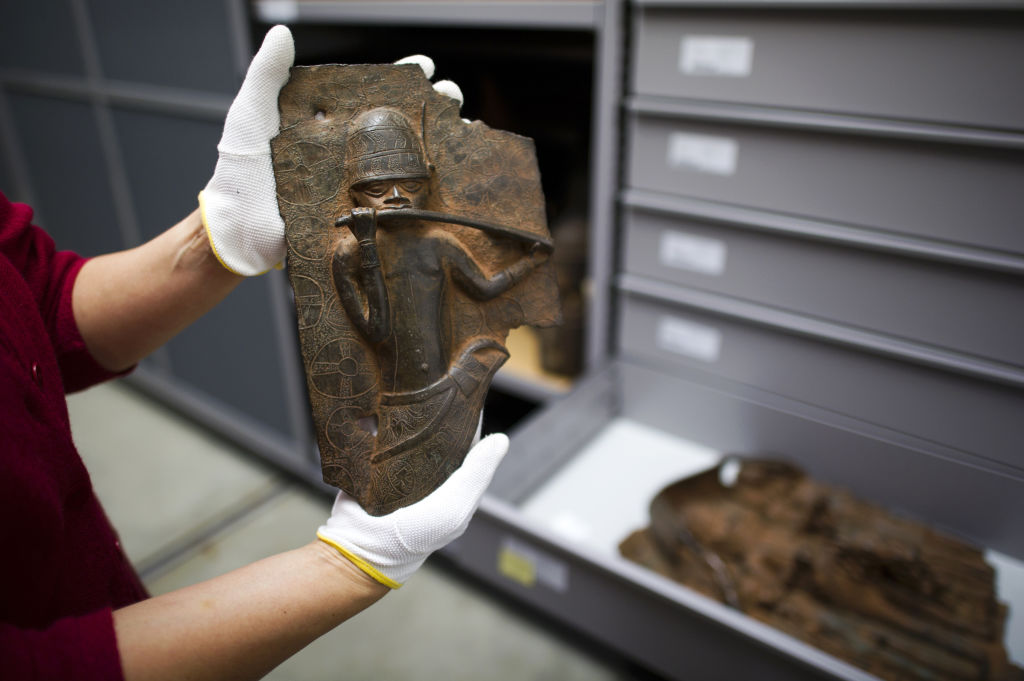
Germany has entered into historic talks to restitute its holdings of Benin bronzes to their home country of Nigeria. The move will have wide-ranging consequences for German museums, not least Berlin’s splashy new Humboldt Forum, and major implications for the growing campaign for restitution across Europe.
Last week, the head of the German foreign ministry’s culture department, Andreas Görgen, traveled to Benin City to enter into discussions with Edo State Governor Godwin Obaseki over the contested Benin bronzes, a historic array of bronze reliefs, carved ivory, and other sculptures that were looted from Benin City by British troops in 1897 when they razed the royal Benin palace in a punitive expedition. Swathes of these objects are today spread out across museums in the West.
Now, Germany says it will return its share of these treasured artworks and artifacts to Nigeria to display at the Edo Museum of West African Art, a museum at the former palace site in Benin City, which is being designed by architect David Adjaye to incorporate some of the ruins.
Full ownership of the museum objects is expected to be transferred to Nigerian officials. In a press statement after their meeting last week, Obaseki confirmed that his government is preparing to launch an independent trust, made up of “the Royal Family, Edo State Government, the Federal Government, and international stakeholders,” to receive the objects.
Görgen said that the German government would assist with the Nigerian program, helping with training and archeological projects onsite, and that he would “ensure the retrieval of the objects.”
Hartmut Dorgerloh, director of the Humboldt Forum, told Artnet News that restitution has not been formally decided and that original reporting on the subject, which stated that the objects will not go on display at Humboldt Forum, were misleading. The Berlin Ethnological Collection, which is set to go on display at the new museum, includes about 530 historical objects from the Kingdom of Benin, including 440 bronzes.
“As far as we know today, the Benin bronzes were largely acquired illegally,” Dorgerloh said in a statement sent to Artnet News, adding that he shares the conviction that there must and will be restitutions, but that the decision will be made by the Foundation Council of the SPK. “What consequences these decisions will ultimately have for the planned presentation of Benin bronzes at the Humboldt Forum is currently being discussed and will decided in consultation with the partners in Nigeria,” Dorgerloh said. “One thing is certain, the exhibition will address the injustices.”
In his press statement last week, Obaseki seemed to indicate that some form of international co-operation was not off the table. “Culture is a living thing,” he said. “Yes, the objects are from Benin but today they are global. So, the idea of having a universal display is something that we cannot run away from.”
Jürgen Zimmerer, a history professor at the University of Hamburg, welcomed the move from the German government, saying it will “fuel the global debate and put pressure on museums around the world, from the British Museum to the Field Museum in Chicago.”
The Humboldt Forum, which officially opened in December, is a €677 million reconstruction of Germany’s former Prussian palace, which has reignited long-simmering debates about Germany’s role in colonialism in the Global South. “The German leaders in politics and museums have run into a dead end,” Zimmerer told Artnet News. “To open the Humboldt Forum in the rebuilt City Palace—this Prussian Disneyland—without having a concept for dealing with looted art—was a disaster.”
Zimmerer noted that this recent announcement is only the tip of the iceberg, as Germany’s problematic holdings of historical objects are vast. “Whether there is a substantial change in policy will be seen in the handling of the dinosaur in the Natural History Museum and the Nefertiti in the Neues Museum, both in Berlin, but above all in the recognition of the genocide of the Herero and Nama, where nothing has been done for years.”
Though a detailed agreement has not been officiated, the news marks an important progression for the growing campaign across Europe for museums to restitute colonial objects from their collections. Other major holdings of the Benin Bronzes are within the British Museum in London and the Musée du Quai Branly in Paris, as well as 25 other museums around Germany.
Pressure for European nations to restitute and atone for their dark colonial legacies has mounted exponentially in recent years. In 2017, the French president Emmanuel Macron declared that African heritage should not longer be held prisoner in French museums, and began a slow march towards developing its own policy for restitution. In 2018, Germany published guidelines for how to manage its colonial holdings and, the following year, released funding for research into provenance of these objects. German state ministers also made a joint declaration on the handling of colonial collections, including the support of restitution where appropriate.
Dan Hicks, scholar and author of The Brutish Museums: The Benin Bronzes, Colonial Violence and Cultural Restitution, told Artnet News that the news reports will “catalyze discussions” among other stakeholders in “the more than 160 museums that currently hold some ten thousand objects looted in 1897.”
“For many, the most striking dimension will be the prospect of restitution of royal and sacred artworks taken by the British being led by a German museum,” Hicks added. “If it’s deemed unacceptable to display these objects on Berlin’s Museum Island, what does this mean for the 45 or more museums in the UK that have Benin objects?”